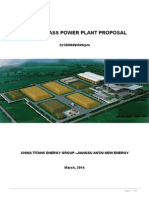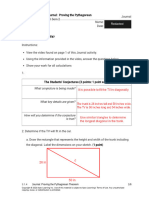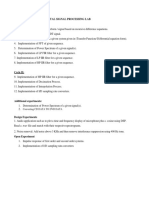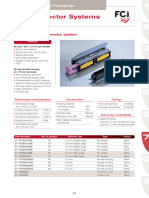Comparison Biogas Vs OWC (500 & 1000 KG)
Comparison Biogas Vs OWC (500 & 1000 KG)
Uploaded by
krayCopyright:
Available Formats
Comparison Biogas Vs OWC (500 & 1000 KG)
Comparison Biogas Vs OWC (500 & 1000 KG)
Uploaded by
krayOriginal Title
Copyright
Available Formats
Share this document
Did you find this document useful?
Is this content inappropriate?
Copyright:
Available Formats
Comparison Biogas Vs OWC (500 & 1000 KG)
Comparison Biogas Vs OWC (500 & 1000 KG)
Uploaded by
krayCopyright:
Available Formats
Description Aindri Biogas Plant Traditional OWC
Image
Process The process is called Anaerobic Digestion/ The process is Aerobic Digestion.
Biomethanation.
Input materials Organic materials like kitchen waste. Organic materials like kitchen waste.
Output materials The Aindri Plant generates Biogas which Organic waste composters generate
can further be converted to cooking gas or compost, which can be used as a natural
electricity. Additionally the plant generates a fertiliser for plants.
nutrient-rich byproduct called digestate,
which can be used as fertiliser.
Maintenance and Lower OPEX, less labour-intensive Higher OPEX, labour-intensive
Operations Cost
AMC provided by us AMC provided
Odour Management Odourless process Potential odour concerns
Area Requirement Compact in size Process involves racking systems and
● 500 KG/Day - 400 Sq. Ft. may require some additional area
● 1000 KG/DAY - 800 Sq. Ft.
Environment Meets the Solid Waste Management and Meets Solid Waste Management Mandate
Clearance and Green Renewable Energy Mandate, therefore only
Building Certifications saves additional CAPEX cost for Solar
Panels
Environmental impact 1. Effective Waste Management OWC cannot capture the gases released
2. Avoid Waste from going to landfills into the environment, thus leading to
3. Reduce Carbon Footprint emissions into the environment.
4. Use biogas for cooking or produce
green electricity
Costs 500 Kg Plant (Electricity Variant) 500 Kg Excel Industries OWC machine
= Rs. 20 lakhs + GST = Rs. 15 Lakhs
(Automatic - Heating element involved)
500 Kg Plant (Gas Variant)
= Rs. 16 lakhs + GST
1000 Kg Plant (Electricity Variant) 1000 Kg Excel Industries OWC
= Rs. 32 lakhs + GST machine
(With Scrubber & 15kva Genset) = Rs. 23.5 Lakhs
(Automatic - Heating element involved)
1000 Kg Plant (Gas Variant)
= Rs. 22.5 lakhs + GST
Saving on Solar Panel Electricity Generated from 1000 Kg Aindri 0 Savings
(Required as per Plant each day
Environment ➢ 100 Units
Clearance Mandate)
Cost of 1kW Solar Panel to generate
Electricity
➢ Rs 70,000
Electricity Generated from 1 kW Solar Panel
per day
➢ 4 Units
Cost Saving on Solar Panel
➢ Rs 17,50,000
Additional savings compared to OWC Setup
Labour Requirement Less labour-intensive: Continuous feeding More labour-intensive:
process with minimal manual intervention
Minimum 2 operators required to
2 labours required segregate, shred, add Bioculum
absorbent to waste, and place raw
compost in curing racks
Operation Time Continuous processing allows for Waste is treated batch-wise, requiring 5
uninterrupted operation. (2-3 hrs per day) hours per day of operation time
Waste Accumulation Continuous processing prevents waste Batch processing results in accumulation
accumulation and minimises odour concerns of waste for longer periods, potentially
leading to odour issues
Electricity Generation Produces electricity as a byproduct Electricity generation may not be a feature
500 KG plant produces 50 units a day
1000 KG plant produces 100 units a day
Qualitative advantages of the Aindri Biogas Plant:
1. Sustainability and Environmental Impact
2. Green Building Certification
3. Enhanced ESG Score (Environmental, Social, and Governance)
4. Local and Community Benefits
5. Circular Economy and Resource Recovery
6. Reputation and Brand Image
★ Showcase a commitment to environmental stewardship and responsible business practices.
Impact
Description Aindri Plant with 500 KG Aindri Plant with 1000 KG Waste
Waste processing processing capacity per Day
capacity per Day
Quantity of waste prevented from reaching the
182500 KG 365000 KG
landfill every year
Quantity of Carbon Emission abetted per year 887 KG 1774 KG
Quantity of Electricity generated per year 18250 KWh 36500 KWh
Quantity of Cooking Gas generated per year 5475 KG 10950 KG
Quantity of Organic Fertilizer Generated per 182500 KG 365000 KG
year (Liquid Manure) (Liquid Manure)
Plant OPEX Details (Electricity)
Opex details (500 Kg Plant)
Component Crusher Pump (Slurry) Blower Compressor Pump (Liquid
Manure)
Rating 3HP 3HP (3φ) 1HP 2HP 3HP (3φ)
Run Time per 15 mins 5 mins 20 mins 10 mins 15 mins
day
Electricity 0.6 units 0.2 units 0.25 units 0.25 units 0.6 units
Consumption
per day
Per day Unit Consumption = 1.9 kWh
Opex details (1000 Kg Plant)
Component Crusher Pump Blower Compressor Pump (Liquid
Manure)
Rating 3HP 3HP (3φ) 1HP 2HP 3HP (3φ)
Run Time per 30 mins 10 mins 40 mins 10 mins 30 mins
day
Electricity 1.2 units 0.4 units 0.5 units 0.25 units 1.2 units
Consumption
per day
Per day Unit Consumption = 3.55 kWh
COMPONENTS DESCRIPTION
Segregation Table DImensions - “1.75m X 1.1m”
Waste is segregated on this table.
Crusher 3 HP crusher
Crusher is used to make a slurry.
Wet waste along with equal amounts of water (1:1) is
added into the crusher.
For 500kg waste = 500 litres of water is required
For 1000kg waste = 1000 litres of water is required
Feed Tank with Pump After crushing, the slurry is collected in the feed tank and
a pump which is inside the tank is used to transfer the
slurry into the digester.
Compressor Power - 2 HP
Used to aerate the digester for 10-15 mins each day
Digester Digester is made up of Mild steel with EPOXY coating on
the inner walls and FRP coating on the outer walls.
Volume of Digester (500kg) = 500kg*2*21 days
= 21000 Litres
Volume of Digester (1000kg) = 1000kg*2*21 days
= 42000 Litres
Gas Storage Balloon with Blower The biogas produced in the digester is stored into the
balloon which comes with a balloon room shed.
Volume of balloon = 30 to 60 cubic metre
1 HP blower is installed to transfer biogas into the
generator
Generator 5 KVA & 15 KVA generators specially made for
converting biogas into electricity.
Changeover Switch + Control Panel with VFD Regulate the current generated for captive consumption
Slurry Overflow Tank with Pump This system includes a solid-liquid separator that
effectively separates solid manure, which is in the form of
a paste, from the liquid portion. The solid manure is
collected on top and can be easily scooped.
Approximately 18-25 kg of solid manure is generated
each day..
Pump is used to transfer the liquid back into the crusher
which forms a cyclic process.
You might also like
- 2KLPD Ethanol Plant ReportDocument16 pages2KLPD Ethanol Plant ReportSaanvira Engineering Pvt Lts100% (1)
- Sampangan Technology DescriptionDocument6 pagesSampangan Technology Descriptionandy rahmadiNo ratings yet
- Waste To Energy Plant PresentationDocument19 pagesWaste To Energy Plant PresentationKamalNo ratings yet
- Lavin PPT 2Document27 pagesLavin PPT 2jjshree79No ratings yet
- 10-Biogass and Fuel CellsDocument56 pages10-Biogass and Fuel CellsHarry DouglasNo ratings yet
- Activated Carbon 2Document4 pagesActivated Carbon 2Eleonore MariaNo ratings yet
- A Brief Introduction To Sampurnearth: Sampurn (E) Arth Environment Solutions Pvt. LTD., Mumbai Email Us @-022 4120 3802Document20 pagesA Brief Introduction To Sampurnearth: Sampurn (E) Arth Environment Solutions Pvt. LTD., Mumbai Email Us @-022 4120 3802aloordominicNo ratings yet
- Bio Methanation PlantDocument6 pagesBio Methanation PlantPradeep ShuklaNo ratings yet
- Industrial Waste Water Treatment-DistilleryDocument7 pagesIndustrial Waste Water Treatment-DistillerysheethalNo ratings yet
- Biogas Model - PreFabrciated PDFDocument9 pagesBiogas Model - PreFabrciated PDFbob krithaNo ratings yet
- Biogas PlantDocument7 pagesBiogas Plantarhan48880% (1)
- Industrial Cogeneration - Vista ProjectsDocument2 pagesIndustrial Cogeneration - Vista ProjectsNei SouzaNo ratings yet
- CalculationsDocument1 pageCalculationsChaitanya IdateNo ratings yet
- K-2-Konsep Pengelolaan Limbah AgroindustriDocument40 pagesK-2-Konsep Pengelolaan Limbah AgroindustriAkbar Shidiq100% (1)
- Nopal Cactus As Biomass For Alternative EnergyDocument3 pagesNopal Cactus As Biomass For Alternative EnergyJoão PedroNo ratings yet
- Bio-Gas: Made By: Kanwaljeet Kritika Minakshi PragyaDocument27 pagesBio-Gas: Made By: Kanwaljeet Kritika Minakshi Pragyaabhivyakti kushwahaNo ratings yet
- APPL Sand Dryer Plant System OverviewDocument9 pagesAPPL Sand Dryer Plant System OverviewnileshNo ratings yet
- Biogas TechnologyDocument35 pagesBiogas Technologyraghunath670743No ratings yet
- Hydrogen and Electrons From ManureDocument38 pagesHydrogen and Electrons From ManureTalib aleemNo ratings yet
- Assignment - Part 1 (Final Year Project) : SupervisorDocument11 pagesAssignment - Part 1 (Final Year Project) : Supervisorannie aliNo ratings yet
- Unep-Dtie-Ietc: Waste Biomass Demonstration ProjectDocument37 pagesUnep-Dtie-Ietc: Waste Biomass Demonstration ProjectApri ApriyantoNo ratings yet
- BIO MASS-2 MarkDocument4 pagesBIO MASS-2 MarkAJITH KANNANNo ratings yet
- Write Up of 220 KLPD Details Ethanol R 01Document9 pagesWrite Up of 220 KLPD Details Ethanol R 01rushikesh.fegadeNo ratings yet
- Eggplant 2 PP4Document13 pagesEggplant 2 PP4Eva CabreraNo ratings yet
- D2 Dinesh Pant Biomass Technology and ImplementationDocument57 pagesD2 Dinesh Pant Biomass Technology and ImplementationBuddhi Raj SharmaNo ratings yet
- Waste To FuelDocument28 pagesWaste To FuelMarco PuccinelliNo ratings yet
- Exe Sum Dharani Sugar EngDocument8 pagesExe Sum Dharani Sugar EngmohammedNo ratings yet
- JAYASHREEDocument12 pagesJAYASHREENilesh ThanviNo ratings yet
- 16021A2536 RAMESH Viva VoceDocument22 pages16021A2536 RAMESH Viva VoceRam Charan KonidelaNo ratings yet
- TOTAL MicroalgaeDocument16 pagesTOTAL MicroalgaesafsyahNo ratings yet
- Suprax - Polymer Panel TankDocument33 pagesSuprax - Polymer Panel TankARR PropertyNo ratings yet
- Nutrigien - Spirulina Oline TrainingDocument39 pagesNutrigien - Spirulina Oline TrainingmandarNo ratings yet
- Uganda 1617K Patil CIRCOTDocument40 pagesUganda 1617K Patil CIRCOTadityaNo ratings yet
- Energy Saving in Textile ProcessingDocument7 pagesEnergy Saving in Textile Processingsaidurtex0% (1)
- Bio Gas Plant - Details 2013Document23 pagesBio Gas Plant - Details 2013lram70No ratings yet
- Cariboo Pulp Paper CompanyDocument19 pagesCariboo Pulp Paper Companymn1938100% (1)
- Biomass Briquette: Use in Thermal Power PlantDocument12 pagesBiomass Briquette: Use in Thermal Power PlantAnjali SahuNo ratings yet
- (Catalog SOFC) PID000155 - FCE - DFC300 - r1 - HiresDocument2 pages(Catalog SOFC) PID000155 - FCE - DFC300 - r1 - HiresppourmoghaddamNo ratings yet
- Biogas Power Plant ConceptDocument5 pagesBiogas Power Plant Conceptluvisfact7616No ratings yet
- Feasibility Report Installation of Bio Gas Plant On Commercial BasisDocument24 pagesFeasibility Report Installation of Bio Gas Plant On Commercial BasisAkhtar AliNo ratings yet
- 10 TPD Biogas Plant DelhiDocument9 pages10 TPD Biogas Plant DelhiRenu Sarath VegesnaNo ratings yet
- Biomass Venkat Rev2 2003Document89 pagesBiomass Venkat Rev2 2003Kumarasabapathy NatarajanNo ratings yet
- Comparative Study of Methods of Biodiesel ProductionDocument24 pagesComparative Study of Methods of Biodiesel Productionjpstark251711No ratings yet
- Food & BiotechDocument48 pagesFood & BiotechPrince ChaudharyNo ratings yet
- Massrearing Montool Dashboard Version 1Document22 pagesMassrearing Montool Dashboard Version 1Zaini AhNo ratings yet
- Detailed Project Report For Biogas Power PlantDocument132 pagesDetailed Project Report For Biogas Power PlantShubham Jain75% (4)
- Vapour Absorption Refrigeration System and Vapour Compression Refrigeration SystemDocument9 pagesVapour Absorption Refrigeration System and Vapour Compression Refrigeration Systemsandip singhNo ratings yet
- Rev - Ankur Sc. - Gasification of Biomass & Waste To Energy & BiofuelsDocument33 pagesRev - Ankur Sc. - Gasification of Biomass & Waste To Energy & BiofuelsbillNo ratings yet
- Steam Turbines and CogenerationDocument46 pagesSteam Turbines and CogenerationBhavesh PatelNo ratings yet
- Biomass To Energy - 2Document43 pagesBiomass To Energy - 2dandewjangerNo ratings yet
- Biogas Calculator TemplateDocument26 pagesBiogas Calculator TemplateRana BiswasNo ratings yet
- Microwave PyrolysisDocument38 pagesMicrowave PyrolysisiimcaemdwNo ratings yet
- Suprax - Polymer Panel TankDocument33 pagesSuprax - Polymer Panel TankARR PropertyNo ratings yet
- Scope of Energy Saving in Textile IndustryDocument28 pagesScope of Energy Saving in Textile IndustryJ.N.Vohra33% (3)
- 2mw Biomass Gasification Gas Power Plant ProposalDocument10 pages2mw Biomass Gasification Gas Power Plant ProposalimyourscinNo ratings yet
- 7 Biogas Technology Practical Uses of Technology JkdbgjrhbgajhbkgjeDocument42 pages7 Biogas Technology Practical Uses of Technology JkdbgjrhbgajhbkgjeJivant gargNo ratings yet
- Electrical Emissions and Carbon Dioxide ReportDocument2 pagesElectrical Emissions and Carbon Dioxide ReportRufus D SNo ratings yet
- MPPCBDocument46 pagesMPPCBspkpalkuNo ratings yet
- Energy Recovery From WasteDocument31 pagesEnergy Recovery From WasteSyed UmerNo ratings yet
- Unlocking Green Energy : A Practical Look at Biogas Production Using Agricultural Biomass and Organic WasteFrom EverandUnlocking Green Energy : A Practical Look at Biogas Production Using Agricultural Biomass and Organic WasteNo ratings yet
- Boiler Company - Industrial Boiler Company - Boiler Factory - EPCBDocument2 pagesBoiler Company - Industrial Boiler Company - Boiler Factory - EPCBkrayNo ratings yet
- 22 EPCB Printed Circuit Board Ideas - Printed Circuit Board, Circuit Board, CircuitDocument2 pages22 EPCB Printed Circuit Board Ideas - Printed Circuit Board, Circuit Board, CircuitkrayNo ratings yet
- ZZ MepDocument1 pageZZ MepkrayNo ratings yet
- Layout Biogas PlantDocument1 pageLayout Biogas PlantkrayNo ratings yet
- PDFDocument8 pagesPDFkrayNo ratings yet
- Screw Replaces Mercedes-Benz 000931 008266 Screw Replaces Mercedes-Benz 000931 008266Document1 pageScrew Replaces Mercedes-Benz 000931 008266 Screw Replaces Mercedes-Benz 000931 008266Alexander NguNo ratings yet
- Definition of Organizational BehaviorDocument6 pagesDefinition of Organizational BehaviorLaeeq Durrani100% (2)
- Substation Desing Training SyllabusDocument7 pagesSubstation Desing Training SyllabusRehan SheikhNo ratings yet
- Lpwan Ieee 802.11ah and Lorawan Capacity Simulation Analysis Comparison Using Ns-3Document4 pagesLpwan Ieee 802.11ah and Lorawan Capacity Simulation Analysis Comparison Using Ns-3Pedrito OrangeNo ratings yet
- CHE10209 Couplings Seals BearingsDocument36 pagesCHE10209 Couplings Seals BearingsFA AyNo ratings yet
- Finally Final SOR 17-18 24.11.2017Document70 pagesFinally Final SOR 17-18 24.11.2017YOGESH aROTENo ratings yet
- Measuring of LightDocument5 pagesMeasuring of LightkijuhgfdsaZNo ratings yet
- Report of PDA Test Pile T29Document20 pagesReport of PDA Test Pile T29bertaNo ratings yet
- 3.1.4 Journal - Proving The Pythagorean TheoremDocument6 pages3.1.4 Journal - Proving The Pythagorean TheoremAnonymous UnanimousNo ratings yet
- Y Cot U: University of The City of ManilaDocument2 pagesY Cot U: University of The City of ManilaVirgilio F. Abundo Jr.No ratings yet
- Samand SE Owner ManualDocument172 pagesSamand SE Owner ManualJesus Alfonzo0% (1)
- EEG-based Emotion Perception During Music ListeningDocument5 pagesEEG-based Emotion Perception During Music ListeningSushrutha Bharadwaj. M100% (1)
- Nursing Leadership Theory Paper ErDocument9 pagesNursing Leadership Theory Paper Erapi-642989736No ratings yet
- Angel Youngs - Google SearchDocument1 pageAngel Youngs - Google SearchJessica VeronicaNo ratings yet
- A2.2 Cell Structure SL HLDocument50 pagesA2.2 Cell Structure SL HLshuhdaNo ratings yet
- DSP Lab FileDocument56 pagesDSP Lab FileKishore AjayNo ratings yet
- HCP Final DraftDocument9 pagesHCP Final Draftapi-439819651No ratings yet
- Fear of Missing Out and PersonalityDocument28 pagesFear of Missing Out and PersonalityBaber Mirza (Prof.Baber)No ratings yet
- Human FactorDocument62 pagesHuman FactorTinesh90No ratings yet
- B2B API Overview: User AuthorizationDocument7 pagesB2B API Overview: User AuthorizationMarcin BojanowskiNo ratings yet
- Research On The Alliance: Knowledge in Search of A TheoryDocument19 pagesResearch On The Alliance: Knowledge in Search of A TheoryJuanaNo ratings yet
- Inglés 9.2Document2 pagesInglés 9.2leonrodri669No ratings yet
- Celta TP2 LP2Document11 pagesCelta TP2 LP2samyah22No ratings yet
- Revision Exercise III No. 1: Test 4Document8 pagesRevision Exercise III No. 1: Test 4Abdulkasim AkhmedovNo ratings yet
- Switchgears: Oil Circuit BreakersDocument4 pagesSwitchgears: Oil Circuit BreakersChristian EstebanNo ratings yet
- Evaluation Form - SAMPLE (CS)Document3 pagesEvaluation Form - SAMPLE (CS)Niv RamNo ratings yet
- Total 8 100% 25 5 5 4 4 4 3Document4 pagesTotal 8 100% 25 5 5 4 4 4 3Edelyn PaulinioNo ratings yet
- AN-123 - AQURA - Configure Espa in & Espa Out ModuleDocument12 pagesAN-123 - AQURA - Configure Espa in & Espa Out ModulegallNo ratings yet
- 56 Way Sealed Connector System Ecu SicmaDocument2 pages56 Way Sealed Connector System Ecu SicmaVolkan ErişNo ratings yet
- True or FalseDocument3 pagesTrue or FalseBarun BhardwajNo ratings yet






























































































